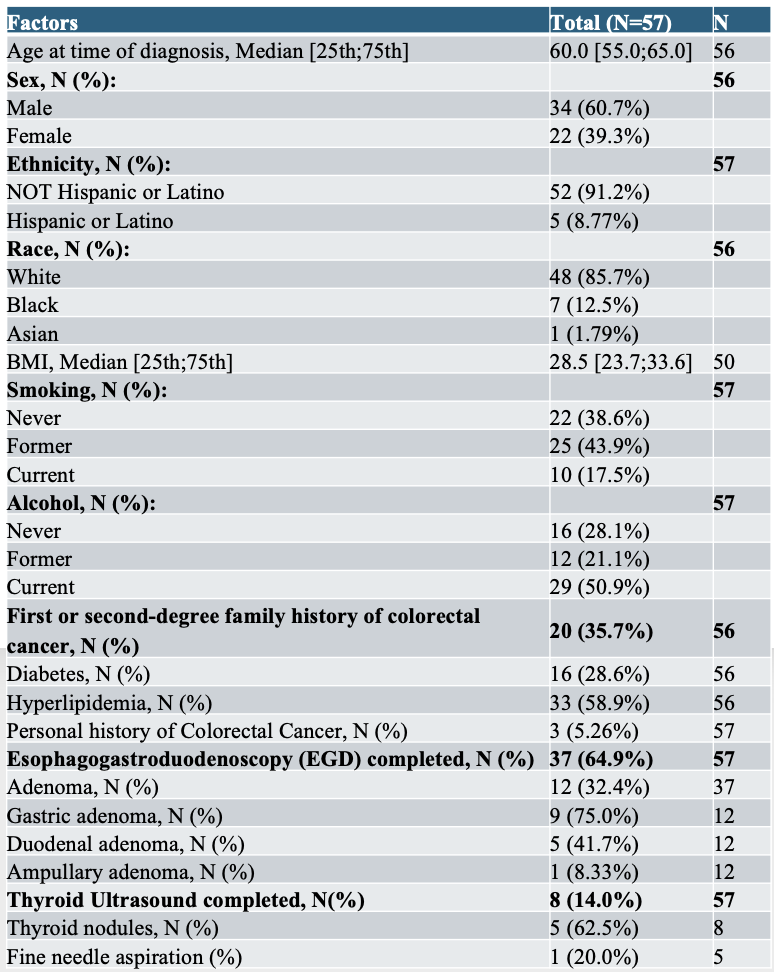Oral Paper Presentation
Annual Scientific Meeting
Session: Plenary Session 3B: Luminal GI / Endoscopy / Pancreas
52 - Clinical Characteristics of Patients With Colonic Oligopolyposis of Unknown Etiology: A Single-Center Experience
Tuesday, October 28, 2025
3:15 PM - 3:25 PM PDT
Location: North Ballroom 120BC

Islam B Mohamed, MD (he/him/his)
Cleveland Clinic Foundation
Cleveland, OH
Presenting Author(s)
Islam Mohamed, MD1, Ahmed N.. Mohamed, MD1, Moath Albliwi, MD1, Qijun Yang, MS2, Chabaklo Khodor, MD3, Yara Shatnawi, MD1, Muaz Alsabbagh Alchirazi, MD4, Carol A.. Burke, MD, MACG2, Carole Macaron, MD2
1Cleveland Clinic Foundation, Cleveland, OH; 2Cleveland Clinic, Cleveland, OH; 3Cleveland Clinic Florida, Cleveland, OH; 4Detroit Medical Center/Wayne State University, Cleveland, OH
Introduction: Colonic oligopolyposis of unknown etiology (CPUE) is defined as the presence of 10–99 cumulative colorectal adenomas in the absence of identifiable pathogenic variants in known polyposis-associated genes. Existing literature on this population is primarily derived from case series using registry databases, which are prone to ascertainment bias. This study aims to characterize the clinical features of patients with adenomatous oligopolyposis using data from a pathology database to better capture a more representative cohort.
Methods: Under IRB approval, we conducted a retrospective chart review using natural language processing to identify patients with 10–99 cumulative colorectal adenomas diagnosed between March 2009 and December 2023 through the Cleveland Clinic’s pathology database. Patients with a known personal or family history of hereditary colorectal cancer syndromes were excluded. Clinical, demographic, and procedural data were collected. Descriptive statistics were used.
Results: Among 385 patients with 10-99 cummulative colorectal adenoma, 118 (30.6%) referred for genetic counseling, and 57 (48%) were diagnosed with colonic oligopolyposis of unknown etiology following negative genetic testing. The median age at diagnosis was 60 years (IQR: 55–65). Of these patients, 34 (60.7%) were male and 48 (85.7%) were White. A majority reported current or former tobacco use (61.4%) and alcohol use (72.0%). A first- or second-degree family history of colorectal cancer was documented in 20 patients (35.7%). Among the 37 patients who underwent upper endoscopy, 12 (32.4%) had upper gastrointestinal adenomas: 9 (75%) gastric, 5 (42%) duodenal, and 1 (8.3%) ampullary. Thyroid nodules were identified in 5 of the 8 patients (62.5%) who underwent thyroid ultrasound. Fine-needle aspiration was performed in one patient, with no thyroid cancer detected (Table)..
Discussion: In our cohort of patients with colonic oligopolyposis of unknown etiology, identified through a single-center pathology database, patients were older males and current or former users of tobacco and alcohol. One-third had a family history of colorectal cancer. Upper gastrointestinal adenomas were present in approximately one-third of patients, consistent with prior studies, underscoring the risk of upper GI neoplasia in this population and supporting the need for upper gastrointestinal surveillance.

Figure: Table . Patients’ demographics and clinical factors, upper endoscopy, thyroid Ultrasound of patients with colonic oligopolyposis of unknown etiology
Disclosures:
Islam Mohamed indicated no relevant financial relationships.
Ahmed Mohamed indicated no relevant financial relationships.
Moath Albliwi indicated no relevant financial relationships.
Qijun Yang indicated no relevant financial relationships.
Chabaklo Khodor indicated no relevant financial relationships.
Yara Shatnawi indicated no relevant financial relationships.
Muaz Alsabbagh Alchirazi indicated no relevant financial relationships.
Carol Burke: emtora biosciences – Grant/Research Support. lumabridge – Consultant. myriad – Food and beverage. Natera – Food and beverage.
Carole Macaron indicated no relevant financial relationships.
Islam Mohamed, MD1, Ahmed N.. Mohamed, MD1, Moath Albliwi, MD1, Qijun Yang, MS2, Chabaklo Khodor, MD3, Yara Shatnawi, MD1, Muaz Alsabbagh Alchirazi, MD4, Carol A.. Burke, MD, MACG2, Carole Macaron, MD2, 52, Clinical Characteristics of Patients With Colonic Oligopolyposis of Unknown Etiology: A Single-Center Experience, ACG 2025 Annual Scientific Meeting Abstracts. Phoenix, AZ: American College of Gastroenterology.
1Cleveland Clinic Foundation, Cleveland, OH; 2Cleveland Clinic, Cleveland, OH; 3Cleveland Clinic Florida, Cleveland, OH; 4Detroit Medical Center/Wayne State University, Cleveland, OH
Introduction: Colonic oligopolyposis of unknown etiology (CPUE) is defined as the presence of 10–99 cumulative colorectal adenomas in the absence of identifiable pathogenic variants in known polyposis-associated genes. Existing literature on this population is primarily derived from case series using registry databases, which are prone to ascertainment bias. This study aims to characterize the clinical features of patients with adenomatous oligopolyposis using data from a pathology database to better capture a more representative cohort.
Methods: Under IRB approval, we conducted a retrospective chart review using natural language processing to identify patients with 10–99 cumulative colorectal adenomas diagnosed between March 2009 and December 2023 through the Cleveland Clinic’s pathology database. Patients with a known personal or family history of hereditary colorectal cancer syndromes were excluded. Clinical, demographic, and procedural data were collected. Descriptive statistics were used.
Results: Among 385 patients with 10-99 cummulative colorectal adenoma, 118 (30.6%) referred for genetic counseling, and 57 (48%) were diagnosed with colonic oligopolyposis of unknown etiology following negative genetic testing. The median age at diagnosis was 60 years (IQR: 55–65). Of these patients, 34 (60.7%) were male and 48 (85.7%) were White. A majority reported current or former tobacco use (61.4%) and alcohol use (72.0%). A first- or second-degree family history of colorectal cancer was documented in 20 patients (35.7%). Among the 37 patients who underwent upper endoscopy, 12 (32.4%) had upper gastrointestinal adenomas: 9 (75%) gastric, 5 (42%) duodenal, and 1 (8.3%) ampullary. Thyroid nodules were identified in 5 of the 8 patients (62.5%) who underwent thyroid ultrasound. Fine-needle aspiration was performed in one patient, with no thyroid cancer detected (Table)..
Discussion: In our cohort of patients with colonic oligopolyposis of unknown etiology, identified through a single-center pathology database, patients were older males and current or former users of tobacco and alcohol. One-third had a family history of colorectal cancer. Upper gastrointestinal adenomas were present in approximately one-third of patients, consistent with prior studies, underscoring the risk of upper GI neoplasia in this population and supporting the need for upper gastrointestinal surveillance.

Figure: Table . Patients’ demographics and clinical factors, upper endoscopy, thyroid Ultrasound of patients with colonic oligopolyposis of unknown etiology
Disclosures:
Islam Mohamed indicated no relevant financial relationships.
Ahmed Mohamed indicated no relevant financial relationships.
Moath Albliwi indicated no relevant financial relationships.
Qijun Yang indicated no relevant financial relationships.
Chabaklo Khodor indicated no relevant financial relationships.
Yara Shatnawi indicated no relevant financial relationships.
Muaz Alsabbagh Alchirazi indicated no relevant financial relationships.
Carol Burke: emtora biosciences – Grant/Research Support. lumabridge – Consultant. myriad – Food and beverage. Natera – Food and beverage.
Carole Macaron indicated no relevant financial relationships.
Islam Mohamed, MD1, Ahmed N.. Mohamed, MD1, Moath Albliwi, MD1, Qijun Yang, MS2, Chabaklo Khodor, MD3, Yara Shatnawi, MD1, Muaz Alsabbagh Alchirazi, MD4, Carol A.. Burke, MD, MACG2, Carole Macaron, MD2, 52, Clinical Characteristics of Patients With Colonic Oligopolyposis of Unknown Etiology: A Single-Center Experience, ACG 2025 Annual Scientific Meeting Abstracts. Phoenix, AZ: American College of Gastroenterology.
